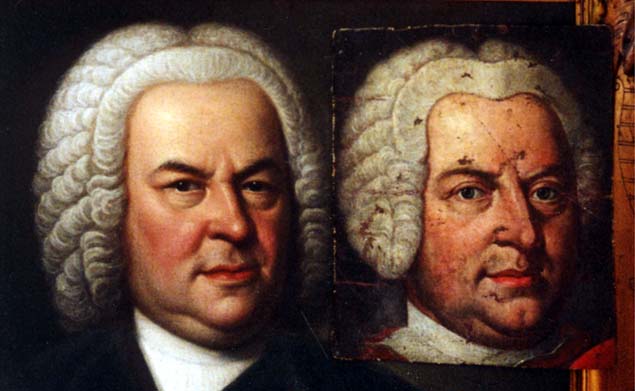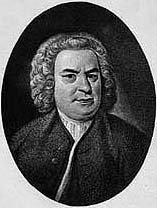The Critical Discographies from Choral Music On Records - Saint Matthew Passion Pages at the Teri Noel Towe
Home Pages
Johann Sebastian Bach
The Critical Discographies from Choral Music On Records
This remarkable photograph is not a computer generated composite; the original of the Weydenhammer
Portrait Fragment, all that remains of the portrait of Johann Sebastian Bach that belonged to his pupil
Johann Christian Kittel, is resting gently on the surface of the original of the 1748 Elias Gottlob Haussmann
Portrait of Johann Sebastian Bach.

1748 Elias Gottlob Haussmann Portrait, Courtesy of William H. Scheide, Princeton, New Jersey
Weydenhammer Portrait Fragment, ca. 1733, Artist Unknown, Courtesy of the Weydenhammer Descendants
Photograph by Teri Noel Towe
©Teri Noel Towe, 2001, All Rights Reserved
The Critical Discographies from Choral Music On Records
Saint Matthew Passion, BWV 244
Saint Matthew Passion, BWV 244
Other Recordings, 1950 - 1989
The recordings of the Saint Matthew Passion published since the bicentenary of Bach's death in 1950 that
have not been previously analyzed in this essay all represent, in varying degrees and proportions,
blendings of the Mendelssohn-Bartholdy tradition, the Ramin/Straube reaction to it, and the pressures
brought to bear by the apostles of authentic performance practice. The collisions of these three
contrasting approaches can have both positive and negative results.
There is no need to waste many words about Ferdinand Grossman's undistinguished traditional account.
[52] A dull conductor, drab pacing, mediocre soloists, and sound that is steely and muddy at the same
time assure that this recording is eminently forgettable. The Gönnenwein reading, which is largely of the
Straube/Ramin variety, looks promising on paper, but it proves a disaster on the turntable. [53] The
performance is drab in toto, but the major problem is the Evangelist, Theo Altmeyer, whose voice is
tattered in the upper registers. He is simply not equal to the demands of the rôle. He declaims the
recitatives at a plodding tempo that makes the narrative didactic and condescending, as if St. Matthew is
telling his listeners, "I'll say this slowly so you'll be sure to understand me." It puts a wet blanket on the
proceedings, in which, by the way, "Mein Jesus schweigt" and "Geduld, Geduld" are presented in the
1741 versions. Only Julia Hamari's dignified, noble, and committed account of the alto solos makes the
Gönnenwein set worth keeping.
Warmer and more gripping are three recordings made outside of Germany. The earliest is a distinguished
Swedish interpretation that was broadcast from the Englebrektskyrkan in Stockholm on February 24,
1963. [54] Under the direction of the highly respected choral conductor, Eric Ericson, the performance is
remarkable for Kim Borg's dignified Jesus and John van Kesteren's Evangelist. Both men have big voices.
Borg's tight small vibrato is not annoying, and van Kesteren's sails clearly and purely into the high registers
without difficulty or tension. The chorus is large and somewhat distant within the reverberant acoustic.
The Frigyes Sandor account was also recorded in concert, on May 23, 1976, at the first performance of
the Saint Matthew Passion in Budapest since 1928. [55] A medium sized chorus is employed, but it has
to be said that the intonation is often terribly gamey. Sandor opts for a relaxed pacing, but his
contemplative and dark hued interpretation never flags, even if all the participants sound a little tired in Part
Two. Vandersteene's thin and plangent voice is a bit tight in the upper registers, but his Evangelist is
compelling and free of mannerisms. Hamari once again gives a sterling account of the alto solos. Sandor
chose the 1741 versions of "Mein Jesus schweigt" and "Geduld, Geduld", and, for once, the gamba is
correctly paired with a harpsichord.
Michel Corboz's 1982 recording is very brisk overall; the interpretation is streamlined but dramatic, and is
a most satisfactory, style conscious, no frills account. [56] Gerhard Faulstisch takes an unpretentious,
conversational approach to the part of Jesus; he is direct and business like. Philippe Huttenlocher shows
himself to be a great singing actor, and he injects much character into the various "minor" roles that he
sings with great conviction. Laudably, none of this gift for characterization intrudes into his
straightforward interpretation of the bass arias. Kurt Equiluz, perhaps the finest Evangelist of the day, lives
up to his well earned reputation, and Anthony Rolfe Johnson is an impassioned and colorful tenor soloist.
The late Mögens Wöldike was one of the pioneers of early music movement and also one of the world's
great choral conductors. A friend and colleague of the incomparable Aksel Schiötz, with whom he made a
stunning and emotionally draining 78 of "Ich will bei meinen Jesum wachen" [57], Wöldike recorded the
Saint Matthew Passion more than a quarter of a century ago, but his graceful, contemplative,
unpretentious, and affectionate account still ranks among the most satisfying ever recorded. [58] Uno
Ebrelius is a dignified and poignant Evangelist, Hans Braun a no-nonsense, clean voiced Jesus. The four
distinguished artists who sing the arias are all in top form, but Max Welrich steals the show. He is the best
Peter of all; he is the only interpreter of that crucial small part who makes the apostle's fear when
challenged and questioned audible.
While he takes into account the many developments in Bach performance practice that has taken place
over the years, Johannes Somary's 1978 recording is the best in the Straube/Ramin tradition; his tempos
are well chosen, his pacing excellent. [59] He also has an excellent group of soloists. This is Ernst
Haefliger's latest recording of the rôle of the Evangelist. Not only does his voice seem warmer and more
supple than it did twenty years before when he first recorded the part for Karl Richter, but also his
interpretation has taken on a warmth, a color, and an emotional clout that it lacked two decades earlier.
There is an innate pathos in Seth McCoy's unique voice that makes his singing of the tenor arias
particularly affecting, and Birgit Finnilä's molten tone is particularly well suited to the alto solos. The
contributions of Elly Ameling, Benjamin Luxon, and Barry McDaniel are also of the first order.
The two orchestras and the two choruses are laid out antiphonally, and the spatial effects have been
effectively captured by the engineers. In addition to using the gamba versions of "Mein Jesus schweigt"
and "Geduld, Geduld", Somary is the only conductor to double the ripieno sopranos in the opening and
closing choruses of Part One with organ, as Bach did in 1736. More conductors who use children to sing
those ripieno parts should follow Bach's and Somary's lead, since such tender young amateur singers are
often both off pitch and tonally acidulous.
The collision of the various performance traditions and conventions that have been - and are - applied to
the Saint Matthew Passion has also created havoc and brought about disaster. Peter Schreier's recording
is a witches' brew of Mendelssohn, Karl Richter, and the faddish trappings of "authentic performance
practice". [60] The opening chorus is taken at a good clip, but the momentum is eviscerated by
"chunka-chunka" articulation and mild sforzandi on strong beats; this unsettling opening is not a good
omen. Schreier injects so much gratuitous articulation into the obligato of "Erbarme Dich, mein Gott" that
all of the plaintive sinuousness is destroyed. The whole performance is fussy and finicky because of his
misguided attempt to be "with it" musicologically. In addition to conducting, Schreier sings the Evangelist;
it is his only unsatisfactory account of the part - undisciplined and dramatic in the pejorative sense of the
term. The patrician and poignant Evangelist that he called forth for Mauersberger, Richter, and Karajan has
evaporated completely. Theo Adam is still a majestic Jesus in spite of it all, but his voice has now
developed a rather pronounced wobble. The 1741 versions of "Mein Jesus schweigt" and "Geduld,
Geduld" are used.
Schreier's sins, however, are insignificant when compared to Raymond Leppard's. [61] His self-indulgent,
egocentric "interpretation" is stuffed with every cheap authentic performance practice conjuror's trick
imaginable, including but not limited to the application of inappropriate embellishments and performance
conventions. For instance, what grounds does Leppard have for thinking that the appogiatura convention
was applicable to narrative recitatives in provincial Saxony in 1736? "Blute nur" is disfigured by the
bizarre intermittent slamming of strong beats. And the catalogue of atrocities goes on and on. The soloists
don't help much. Jon Garrison produces an unpleasant constricted sound to begin with and exacerbates
matters with a pretentious operatic over-interpretation of the rôle of the Evangelist; at least his approach is
congruent with Leppard's flashy and fussy doings. This performance, in which the 1741 versions of
"Mein Jesus schweigt" and "Geduld, Geduld" are used, can safely be said to be the only one on records
that will arouse the righteous ire of all sensitive listeners who have the courage to confront it.
Please click here to advance to Page 6 - Summary.
Endnotes
Alphabetical Discography
Please click here to return to the Critical Discographies from Choral Music On Records Main Page.
P. S.: Please don't forget that, if you are interested in a thorough, accurate discography of the recordings
of the Saint Matthew Passion that have appeared since the preparation of this article, you should go at
once to Aryeh Oron's remarkable Bach Cantatas Website.
Please click on  to return to the Johann Sebastian Bach Index Page.
to return to the Johann Sebastian Bach Index Page.
Please click on the  to return to the Teri Noel Towe Welcome Page.
to return to the Teri Noel Towe Welcome Page.
teritowe@alumni.Princeton.EDU
Copyright, Teri Noel Towe, 1989, 1997, 2001
All Rights Reserved
The The Critical Discographies from Choral Music On Records - Saint Matthew Passion Pages
at the Teri Noel Towe Home Pages are PPP Free web pages.

The The Critical Discographies from Choral Music On Records - Saint Matthew Passion Pages
at the Teri Noel Towe Home Pages have received the HIP Woolly Mammoth Stamp of Approval from
The HIP-ocrisy Home Page.